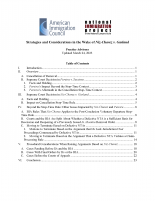- Practice Advisories
Strategies and Considerations in the Wake of Niz-Chavez v. Garland
Published
In Niz-Chavez v. Garland, 593 U.S. 155 (2021), the Supreme Court held that a Notice to Appear must convey the time and place of the hearing in a single document in order to trigger the stop-time rule in cancellation of removal cases, and that a subsequently-issued hearing notice does not stop time if the Notice to Appear did not include the required information. Following Niz-Chavez, the U.S. Courts of Appeals and the Board of Immigration Appeals (BIA) have interpreted the holding and applied the case to a variety of situations. In its June 2024 decision Campos-Chavez v. Garland, 144 S. Ct. 1637 (2024), the Supreme Court held that a defective NTA is not a sufficient basis for rescinding and reopening an order of removal entered in absentia.
This updated practice advisory, by the American Immigration Council and the National Immigration Project, provides:
- An overview of the Pereira v. Sessions and Niz-Chavez v. Garland decisions and their impact on eligibility for cancellation of removal;
- A discussion of the potential effects of Niz-Chavez on eligibility for post-conclusion voluntary departure;
- An overview of the Campos-Chavez v. Garland decision and its impact on motions to rescind and reopen;
- Broader applications of relevant Supreme Court, BIA, and Circuit court decisions, including potential arguments for seeking termination of removal proceedings based on defective Notices to Appear; and
- Vehicle, timing, and geographical considerations when raising Niz-Chavez v. Garland-based arguments.

